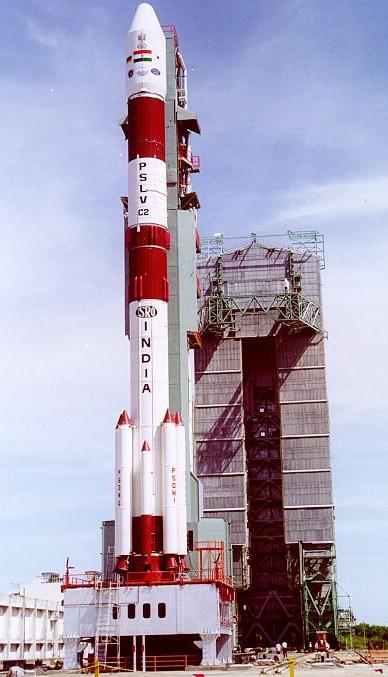The PSLV is the workhorse rocket of ISRO with an outstanding success rate amongst medium lift rocket systems. The success of the POLAR Satellite Launch Vehicle (PSLV) is an important milestone for the Indian space industry. India has achieved self-sufficiency in launching its operational satellites.
The PSLV is a unique vehicle which employs both liquid and solid fuel engines, and it is ISRO's workhorse. The PSLV can place a satellite weighing about three tonnes in low earth orbit (LEO), at a height of 400 to 600 kms. It can also deploy satellites weighing up to 1,500 kg in Polar Sun Synchronous orbit at a height of 750 kms above the earth, as it has done in the case of the Indian Remote-Sensing Satellites (IRS) constellation. This versatile and flexible vehicle can handle a LEO, a polar and a GTO orbit. The Vikram Sarabhai Space Centre (VSSC) in Thiruvananthapuram is the key centre for building the PSLV. Its director and presently ISRO chairman
Shri. G Madhavan Nair, is acknowledged as the "father of the PSLV programme".
PSLV was initially designed for launching 900 kg Indian Remote Sensing Satellites (IRS) into a 900 km polar sun synchronous orbit. Since its first launch in 1993, it has been successively improved to enhance its capability. The latest PSLV configuration is 44.4 metre tall and weighs 295 tonnes.
The changes include improvements made in the performance of the third stage solid propellant motor by optimising the motor case and propellant loading. Also the propellant in the fourth stage liquid motor was increased from 2.0 tonnes to 2.5 tonnes. Besides this, the PSLV now employs a carbon composite payload adapter, resulting in substantial payload advantage.
PSLV has four stages using solid and the
Vikas liquid propulsion engines alternately.
The
First Stage is one of the largest solid propellant boosters in the world and carries 138 tonne of Hydroxyl Terminated Poly Butadiene (HTPB) based propellant. It has a diameter of 2.8 m. The motor case is made of maraging steel. The booster develops a maximum thrust of about 4,628 kilo Newtons (kN). Six strap-on motors, four of which are ignited on the ground, augment the first stage thrust. Each of these solid propellant strap-on motors carries nine tonne of HTPB propellant and produces 662 kN thrust.
The
Second Stage employs indigenously manufactured
Vikas liquid engine which carries 40.0 ton of 'Unsymmetrical Di-Methyl
Hydrazine' (UDMH) propellant as fuel and Nitrogen Tetroxide as oxidizer. It generates a maximum thrust
of about 725 Kn.
The
Third Stage uses 7.6 tonne of HTPB-based solid propellant and produces a maximum thrust of 260 kN. Its motor case is made of polyaramide fibre composite.
The
Fourth and the Terminal Stage of PSLV has a twin engine configuration using liquid propellant. With a propellant loading of 2.5 tonne (Mono-Methyl Hydrazine and Mixed Oxides of Nitrogen), each of these engines generate a maximum thrust of 7.4 kN.
The 3.2 m diameter metallic bulbous payload fairing of PSLV protects the spacecraft during the atmospheric regime of the flight. PSLV employs a large number of stage auxiliary systems for stage separation, heat-shield separation and equipment jettisoning.
